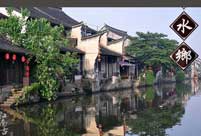 Chinese Kung Fu charms Silicon Valley
Chinese Kung Fu charms Silicon Valley
 Tranquil Yankou ancient town
Tranquil Yankou ancient town
 Lake Geneva: A show of swans
Lake Geneva: A show of swans
 Beautiful sunset over the Irtysh River
Beautiful sunset over the Irtysh River
 Qingjing Mosque: Witness of the ancient Maritime Silk Road
Qingjing Mosque: Witness of the ancient Maritime Silk Road
 Neiliansheng – more than 100 years of fashion
Neiliansheng – more than 100 years of fashion
 Golden retriever feeds baby African lions
Golden retriever feeds baby African lions
 Strange rocks in Lama Mountain
Strange rocks in Lama Mountain
 First overseas "China-standard" electric railway laid
First overseas "China-standard" electric railway laid
 College graduate launches organic agricultural cooperative in hometown
College graduate launches organic agricultural cooperative in hometownWalking into Tunba Village, Tunba Town, Nyemo County, Lhasa City, you will be refreshed by the view of the green hills and clear waters, luxuriant trees and grass, in which you can hear the trickling water of a brook and smell the delicate fragrance of cypress. As seen from a distance, more than 200 odd water mills at various sizes for grinding the raw materials of Tibetan incense are distributed along the Tunqu River running across the village.
One can simply be attracted enough to such a corridor of water mills, let alone it is also the hometown of Thonmi Sambhota, the creator of Tibetan language. This picturesque small village coming into your sight is not only the origin place of Tibetan incense but the largest production base in current Tibet. With the gurgling water wheel turning day after day and year after year, the Tibetan incense of Nyemo renowned at home and abroad is produced in batches from these water mills.
The Tibetan handicraft products featured by Tibetan incense are the cultural treasures created by Tibetan people through the accumulation and integration of traditional culture, ethnic characteristics, custom and geographical resource in the past thousands of years, of which the profound Tibetan cultural heritage and ethnic style has enjoyed a great popularity home and abroad, gaining unique comparative advantages on the market.
Lhasa is the place with the largest development scale, widest variety and highest trade concentration of Tibetan handicrafts. The national handicraft products in Lhasa are mainly composed of such 9 major series and 17 classes as knitting (the Tibetan tapestry), sculpture (woodcarving, stone carving, Tibetan furniture, classic architecture), metalware (goldware, silverware, bronzeware, Tibetan knives), painting and embroidery (Thangka), Tibetan clothing, Tibetan incense, Tibetan paper, tents, religious articles and travel products etc., among which the most famous are the Tibetan tapestry, Thangka, Tibetan incense, goldware, silverware, bronzeware, Tibetan knives and Tibetan clothing. The products are sold throughout the entire Tibet Autonomous Region and the Tibetan-inhabited areas in Yunnan, Sichuan, Qinghai, Gansu etc., and even exported to more than a dozen countries and regions such as Southeast Asia, Japan, Europe and America.
The Fifth Tibet Work Forum held by the Central Government has presented “based on a standpoint of Tibetan resource conditions, industrial base and national strategic needs, make overall plans and scientific layouts, make a special effort to nurture the strategic pillar industries with characteristics and comparative advantages”. National handicraft industry is one of three main traditional industries in Tibet (besides animal husbandry and crop plantation),enjoying a wide mass base, long-standing historical heritage and broad market prospects; with distinct Tibetan culture and other resource endowments, a certain industrial base and significant comparative advantages, the handicraft industry is one of “six major industries” obtaining a special attention in the current great-leap-forward development of Lhasa.
Tibetan handicraft products can be classified into such two categories by purpose as special supplies for Tibetan (including necessities for Tibetan livelihood and production and religious articles) and non-special supplies for Tibetan (national artworks and tourist souvenirs). At present, the Tibetan handicraft products are mainly special supplies for Tibetan and seldom national artworks and tourist souvenirs. In regard to the capacity of the market, the special suppliers are targeted at the special consumer group -- Tibetan people who stand for a relatively small market. But the non-special suppliers, i.e. national artworks and tourist souvenirs, are targeted at people of all kinds from no matter what ethnic group or region who are their actual and potential consumers. Obviously, the market potential of special supplies is relatively limited while the other possesses huge market potential and development space.
“Lhasa national handicraft industry shall stick to such principles as integrating preservation with innovation, leading companies’ traction with enterprise cluster’s effect, governmental support with business initiative; with the precondition by meeting Tibetan special needs, put great efforts into enhancing the development and supply of national artworks and tourist souvenirs; at the same time, promote the conversion of national special supplies into tourist souvenirs to step up the great-leap-forward development of national handicraft industry.” said Qi Zhala, Member of the Standing Committee of the CPC Tibet Autonomous Region and Secretary of the CPC Lhasa City; following the direction of market-oriented, industrialized and socialized development, on the platform of constructing the national handicraft industrial park, strive to put forward the development, production and sales of national tourism products, speed up the development of distinct national handicraft industry, so as to achieve the sales target of RMB1 billion, over 30% annual growth, collect taxes more than RMB50 million and create over 4000 jobs by 2015.
It is reported that Lhasa National Handicraft Industrial Park is going to break ground in the industrial part of Dazi County this year, of which the construction is expected to be completed in three phases with the first phase planning to cover 525 mu to accommodate at least 30 commercial tenants. The estimated investment in this year is RMB100 million and the total investment shall reach no less than RMB800 million. After its completion, the national handicraft industrial park will integrate such eight functions as cultural display, sightseeing, product exchange, information communication, creative research and development, professional training, manufacturing, business service into one entity, highlighting intensiveness, openness, professionalism, diversity, impenetrate with unique Tibetan culture and its national handicraft industrial economy as the principal line, divided into such four functional areas as theme pavilion, exhibition area, service area and production area.
“After the completion of Lhasa National Handicraft Industrial Park, according to the inherent law that tourism and national handicraft industry helps each other forward, establish a closely-cooperative and benefit-sharing mechanism between Lhasa national handicraft industry and tourism through this industrial park.” said Wang Xuguang, Director of Dazi County Industrial Park Management Committee.
 Opening ceremony of 67th Cannes Film Festival
Opening ceremony of 67th Cannes Film Festival Pulse of Xiamen - Int'l Yoga art festival in May
Pulse of Xiamen - Int'l Yoga art festival in May Photo story: Life of a scrap metal recycle worker
Photo story: Life of a scrap metal recycle worker Training of the PLA's first female honor guard
Training of the PLA's first female honor guard China's 10 must-see animations
China's 10 must-see animations Female bodybuilders show their beauty of fitness
Female bodybuilders show their beauty of fitness A taste of Harbin cuisine
A taste of Harbin cuisine A bite of Jiang Nan
A bite of Jiang Nan Who is China's campus beauty queen?
Who is China's campus beauty queen? 8 great movies to watch with your mom
8 great movies to watch with your mom China's most luminous celebrities
China's most luminous celebrities Newly recruited police in Hetian hold drill
Newly recruited police in Hetian hold drill  Bird-men compete flying in Hong Kong
Bird-men compete flying in Hong Kong  The 'Chinese Dad'
The 'Chinese Dad' Shanghai locals bid farewell to childhood memories
Shanghai locals bid farewell to childhood memoriesDay|Week|Month